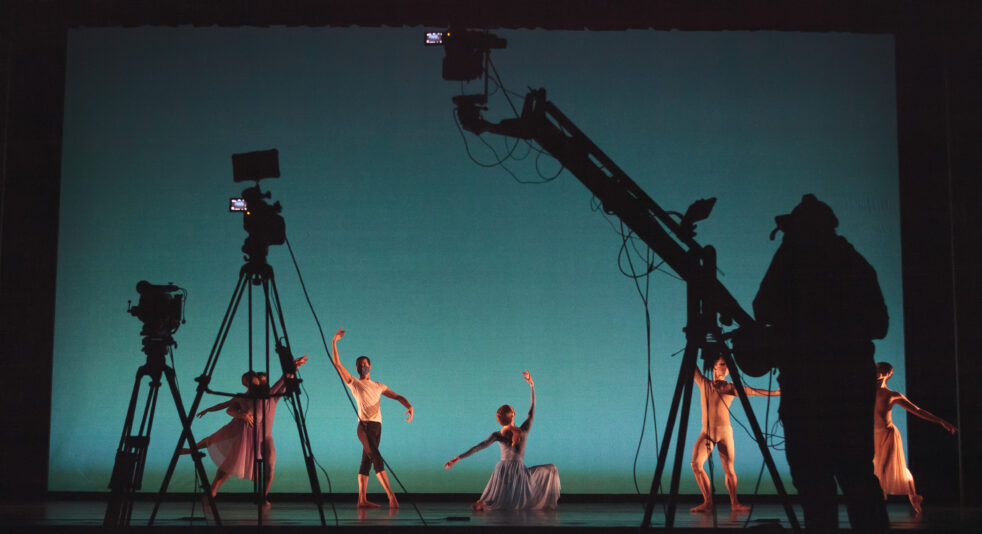Correction: An earlier version of this story erroneously identified the Rialto Center for the Arts at Georgia Southern University. The arts center is located at Georgia State University.
Of all the industries that have suffered during the COVID-19 pandemic, the performing arts have arguably been one of the hardest hit.
No virtual intermediary can fully capture the magic of live music, theater or dance, and when it comes to financial support, many performing arts companies have found themselves at the bottom of the totem pole.
But art is necessary in times like these, and the industry has demonstrated its resilience many times since the pandemic began.
Atlanta Ballet’s recent performance of “Silver Linings” is one example of the ways that passionate people have overcome the challenges of the day in order to bring art to their audiences.
“Silver Linings” was live streamed from the Rialto Center for the Arts at Georgia State University, and featured the company of the Atlanta Ballet in its first live performance in a year.
The dancers performed wearing masks, which was slightly off-putting at first glance but quickly became unnoticeable.
The program included six pieces, five of which were choreographed by company dancers.
The sixth was a preview of Choreographer-in-Residence Claudia Schreier’s newest work, “Pleiades Dances.”
Following introductions by Lee Foster, the Rialto’s director, and Atlanta Ballet Artistic Director Gennadi Nedvigin, the program opened with Anderson Souza’s “Touchline,” set to music by Chopin.
“Touchline” was one of the heavier pieces on the program, and features a cast of six dancers costumed in simple white tank tops and trousers, moving through a series of sculptural, grounded shapes. The piece was inspired by the events of the pandemic and the experience of being unable to touch or be close to another person.
Dancer-turned-choreographer Keith Reeves described his ballet, “Bodies in Motion,” as a “mixed-media conceptual piece” that was inspired by his family history, with a score engineered by Atlanta artist Ptar around recorded conversations that Reeves had with his grandmother. The piece combines floorwork and modern shapes with classical movements, with a six-person cast that danced either in silhouette or in shadow.
“‘Bodies in Motion’ is my love letter to culture and the ever-evolving beauty of diversity,” Reeves said.
Guilherme Maciel’s “This Bitter Earth,” choreographed to the eponymous music of Max Richter and Clyde Lovern Otis, featured three female dancers in knee-length black slips and pointe shoes.
“This Bitter Earth” can be an intimidating piece of music for a young choreographer given the existence of world-renowned choreographer Christopher Wheeldon’s famous pas de deux to the song, but Maciel’s piece is beautiful and memorable in its simplicity. With its poignant score, expressive neoclassicism and dreamy atmosphere, Maciel’s piece is an understated reminder that “this bitter earth may not be so bitter after all.”
Two movements from Claudia Schreier’s newest work for the company, “Pleiades Dances,” offered viewers a preview of the second installment of “Silver Linings,” which will take place on March 19 and include the world premiere of “Pleiades Dances.” The ballet is set to music by Takashi Yoshimatsu, and Schreier said that she based the work off of Yoshimatsu’s “complex rhythms and time signatures.”
“Dr. Rainbow’s Infinity Mirror,” choreographed by company member Darian Kane to music by Miracle Musical, is a whimsical tribute to Kane’s inspirations:
Wes Anderson, Quentin Tarantino, Danny Elfman, and Tim Burton.
Like her muses, Kane’s piece is quirky, a little dark, and wildly entertaining, and features three dancers dressed in black with brightly colored socks and dramatic makeup above their masks.
“If I could take all of their talent and put it into a person, that would be this crazy character Dr. Rainbow, who splits herself into multiple personalities to entertain herself and to create a magical world,” Kane said.
The program closed with Sergio Masero’s “Teneo Integrum,” by far the most classical of all the pieces. Set to music by Tchaikovsky and Schubert, “Teneo Integrum” is an ode to ballet’s traditional roots, and was the only work to include an extended pas de deux between its leading couple.
“During the quarantine I was inspired by dancers all around the world who were keeping this art form alive,” Masero said, “I started thinking of how strong it is and how much passion to keep it alive every dancer has. And I wanted to celebrate that in my choreography.”
The first installment of “Silver Linings” offered audiences the next best thing to attending an actual performance: dancers performing live in a real theater.
While the show wasn’t without its defects — the applause-free bows were a little eerie, for instance — it offered a close-up look at an impressive group of dancers doing what they do best.
“This year has been unpredictable, draining, chaotic, and isolating,” Nedvigin said in his opening address, “But despite the challenges, we have fought to find the silver linings of our circumstances.”
“Silver Linings” is available to watch on the Rialto Center’s Youtube channel.
Stay tuned for a second installment on Mar. 19, which will live stream on Facebook and will include the world premiere of “Pleiades Dances.”
